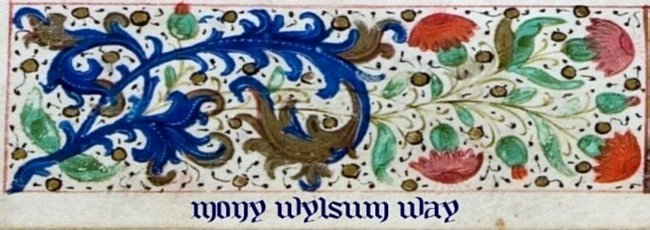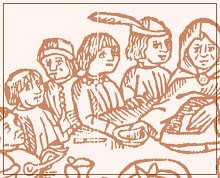So, in an attempt to get all this information straight in my head, I’m going to do a blog post about it.
I’m trying to reconstruct a reasonably thorough codicological description of Cotton Cleopatra D IX, a codex which is an early modern collection of three, five, seven or eight 14th century mss (depending on how you count). It is, by the way, the codex that includes the short monastic chronicle of the civil wars of Edward II which I was translating [??] a while back. There’s a lot of missing information, much of it simply lost to time but a frustrating amount which could be resolved by looking at the codex. Or if any of the scholars who have, over the past century, commented on various articles within the codex had bothered giving trivial details about things like, oh, size of the page, or which pages are more worn than others, or whether the titles given to various entries are in a contemporary hand or an early modern one, or in fact only exist in the catalogue, and trifling little details like that. The most recent catalogue for the Cotton mss was published in 1802, and it’s rather cursory. I hear there’s another catalogue in process, due to be completed at the end of 2009, so this post may be rendered obsolete or proved inaccurate in several points within a few months – here’s hoping!
In brief, the main five manuscripts:
- a collection of historical writing from the Benedictine abbey of Lichfield,
- a brief chronicle from 1066-1314 from Gloucester or thereabouts,
- a chronicle with supporting documents relating to the events of 1322 and their aftermath from the Augustinian priory of Fineshade,
- a treatise of advice (speculum) to Edward III on the bad management of the kingdom,
- a fragment of a few saints’ lives from the South English Legendary, probably from the 1340s, somewhere around Gloucestershire or Oxfordshire.
We can call it six if we include the two leaves from a 14C service book which help to bind the codex as a while; seven if we count the single leaf attached to the Fineshade chronicle which appears to be an official proclamation from 1325; and, at a stretch, eight, if we count the two (almost) blank leaves binding the South English Legendary section.
So there is a certain thematic and temporal coherence, particularly if one considers the saints’ lives as historical sources on much the same footing as the other documents (as most people in this period would). The trouble is that they weren’t assembled in the 1300s – there’s no reason to think that the two whose origin we can pinpoint left Fineshade and Lichfield before they were dissolved by Henry VIII (1536 and 1538 respectively). And yet the Speculum Edwardi III is written on paper. It must have been kept very, very carefully to still be legible even by the 1500s, never mind by 2009, and I find it very hard to believe that it wasn’t bound up with other (parchment) mss very early to have survived at all. There is also thematic continuity between the Speculum and the concerns of the Fineshade chronicler in the manuscript immediately preceding it, though that may be just coincidence; but the ordering of the first four mss suggests a very careful grouping and consideration and knowledge of contents (and the historical events to which they refer), managing to approximate a chronological order for a chronologically complex group of texts. And yet, this care for the text is not reflected in the vandalism of a service book to bind them - unless it’s specifically a care for the text, not the manuscript? Or the binder had plenty of service books at his disposal (post-dissolution, presumably) and considered them far too ornate and popish (and common) to be worthy of the respect accorded to these more unique documents? Or were these four mss grouped by one person, and later bound together with the SEL fragment by another?
I’ll throw in a name at this point – Sir John Price, originally Ap Rhys (born in Wales, but built up quite a career in London before retiring to Herefordshire). He was heavily involved in the dissolution of the monasteries in the 1530s, gathered an extensive personal library from their collections, and we know that he had at least the SEL fragment in his possession. Possibly he was the one to bind it with the two folios that surround it in the codex: we know he was opposed to rebinding volumes that were already bound, and we owe the preservation of many fine 11C volumes to his opinions in that regard. However, the SEL fragment was already broken up and had lost many leaves already (we don’t know how many because every collection of the SEL is different, so there’s no way of knowing how many legends this ms originally contained), and both the first and the last leaves extant are damaged. Preservation, in this case, would have meant protection rather than his usual more hands-off approach.
He would not, however, have been the man to bind the ms together with the other four. He may have owned them all – at least the first three of the five seem to be monastic in origin – but unfortunately the monasteries that we can identify as dissolved by Price are all concentrated around the Welsh border (Herefordshire, Gloucestershire, Shropshire, Worcestershire). The brief chronicle from around Gloucestershire might have fallen into his hands, but he would be venturing rather afield to reach Lichfield in Staffordshire, and Fineshade (Northamptonshire) would seem to be far outside his purview. So it’s more probable that either he acquired them later, or that when his library was broken up at his death a friend with similar interests acquired those mss Price had, and this other collector combined them with one or more of his own collection to form the codex we have now. This other collector may have been Cotton – does anyone know how likely Cotton would have been to bind this sort of collection together? – but it may also have been someone else from whom Cotton later acquired this volume as it now stands.
So that’s a simple overview of what we know about the later history of the mss in Cotton Cleopatra D IX – more questions than answers. The whole codex in itself presents (or in some cases, tries to obscure) an interesting story, or set of questions, about the production and dissemination and collection of manuscripts from the fourteenth century onwards. It is, after all, essentially a collection of collections, or possibly a collection of collections of collections. I still have no firm answers to almost anything about this book, and all the visible trails are broken at least once or consist of nothing more than a single point. But we have enough that we can see the broad strokes of the picture, and a few random finer ones that don’t really make up anything comprehensible, but which allow us to consider the more human aspects behind inspiration, purpose, production, retention, collection, in ways that may not answer any questions definitely, but at least give us plenty of other interesting and more germane questions to consider.





.jpg)

